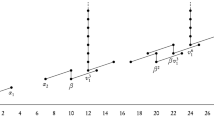Abstract
This paper is devoted to a constructive version of the Bousfield–Kan spectral sequence (BKSS). The BKSS provides a combinatorial basis for the famous Adams spectral sequence and its descendants. Its systematic description in the book “Homotopy Limits, Completions and Localizations” remains a relatively difficult text, often cited by its sweet nickname, the “Yellow Monster.” The modern constructive point of view gives an opportunity to reread this essential text and to use it to produce a new algorithm computing homotopy groups, more precisely computing the effective homotopy of a given space, a new concept much richer than the ordinary homotopy groups. Without changing the general philosophy of the BKSS, the constructive constraint leads to a significant reorganization of this rich material and, as it is most often the case, finally to a simpler and more explicit description. Combined with our own basic tools, effective homology and effective homotopy, the description of the BKSS given here is finally not so complicated and could also help the topologists interested by this nice subject.


Similar content being viewed by others
Notes
The main successes of effective homology have been obtained for the homology groups of the loop spaces, where the Adams and Baues methods cannot be iterated beyond the second loop space [26].
References
J. F. Adams, On the non-existence of elements of Hopf invariant one, Annals of Mathematics 72(1) (1960), 20–104.
C. Berger, Une version effective du thorme de Hurewicz, Ph.D. Thesis (1991), http://math.unice.fr/~cberger/these.
E. Bishop and D. Bridges, Constructive Analysis, Springer, 1985.
A. K. Bousfield and D. M. Kan, The homotopy spectral sequence of a space with coefficients in a ring, Topology 11 (1972), 79–106.
A. K. Bousfield and D. M. Kan, Homotopy Limits, Completions and Localizations, Lecture Notes in Mathematics, Springer, New York, 1972.
E. H. Brown, Finite computability of Postnikov complexes, Annals of Mathematics 65(1) (1957), 1–20.
H. Cartan, Algèbres d’Eilenberg-MacLane et homotopie, Séminaire H. Cartan, École Normal Supérieure, Paris : Exposés 2–11, 1954–1955.
X. Dousson, J. Rubio, F. Sergeraert and Y. Siret, The Kenzo program, Institut Fourier, Grenoble, 1999, http://www-fourier.ujf-grenoble.fr/~sergerar/Kenzo/.
R. Forman, Morse theory for cell complexes, Advances in Mathematics 134 (1998), 90–145.
P. G. Goerss and J. F. Jardine, Simplicial Homotopy Theory, Birkhäuser, 1999.
T. Kaczynski, K. Mischaikow, and M. Mrozek, Computational Homology, Applied Mathematical Sciences, Springer, 2004.
S. O. Kochman, Stable homotopy groups of spheres, Lecture Notes in Mathematics, Springer, New York, 1990.
S. O. Kochman and M. E. Mahowald, On the computation of stable stems, in: The Cech Centennial: A Conference on Homotopy Theory, AMS Contemporary Mathematics, vol. 181, 1995.
M. Krc̆ál, J. Matous̆ek and F. Sergeraert, Polynomial-time homology for simplicial Eilenberg–MacLane spaces, Foundations of Computational Mathematics 13 (2013), 935–963.
S. MacLane, Homology, Springer, 1963.
J. McCleary, User’s guide to spectral sequences, second edition, Cambridge University Press, 2001.
J. P. May, Simplicial objects in Algebraic Topology, Van Nostrand Mathematical Studies, University of Chicago Press, 1967.
R. Mikhailov and J. Wu, On homotopy groups of the suspended classifying spaces, Algebraic and Geometric Topology 10 (2010), 565–625.
D. C. Ravenel, Complex cobordism and stable homotopy groups of spheres, Academic Press, 1986.
A. Romero, Effective Homology and Spectral Sequences, Ph.D. Thesis, Universidad de La Rioja, 2007. http://www.unirioja.es/cu/anromero/tesis
A. Romero, Computing the first stages of the Bousfield-Kan spectral sequence, Applicable Algebra in Engineering, Communication and Computing 21 (2010), 227–248.
A. Romero and J. Rubio, Homotopy groups of suspended classifying spaces: an experimental approach, Mathematics of computation 82 (2013), 2237–2244.
A. Romero and F. Sergeraert, Effective homotopy of fibrations, Applicable Algebra in Engineering, Communication and Computing 23 (2012), 85–100.
A. Romero and F. Sergeraert, Programming before Theorizing, a case study, in Proceedings International Symposium on Symbolic and Algebraic Computation, ACM, 2012, pp. 289–296.
A. Romero and F. Sergeraert, A combinatorial tool for computing the effective homotopy of iterated loop spaces, Discrete and Computational Geometry 53 (2015), 1–15.
J. Rubio and F. Sergeraert, Constructive Algebraic Topology, Bulletin des Sciences Mathématiques 126(5) (2002), 389–412.
J. Rubio and F. Sergeraert, Constructive Homological Algebra and Applications, Unpublished results (2006), http://arxiv.org/abs/1208.3816.
F. Sergeraert, The computability problem in Algebraic Topology, Advances in Mathematics 104(1) (1994), 1–29.
J. Whitehead, Simple homotopy types, American Journal of Mathematics 82 (1960), 1–57.
Author information
Authors and Affiliations
Corresponding author
Additional information
Communicated by Herbert Edelsbrunner.
This study was partially supported by Ministerio de Economía y Competitividad, Spain, project MTM2013-41775-P.
Rights and permissions
About this article
Cite this article
Romero, A., Sergeraert, F. A Bousfield–Kan Algorithm for Computing the Effective Homotopy of a Space. Found Comput Math 17, 1335–1366 (2017). https://doi.org/10.1007/s10208-016-9322-z
Received:
Revised:
Accepted:
Published:
Issue Date:
DOI: https://doi.org/10.1007/s10208-016-9322-z
Keywords
- Bousfield–Kan spectral sequence
- Effective homotopy
- Combinatorial algebraic topology
- Symbolic computation



